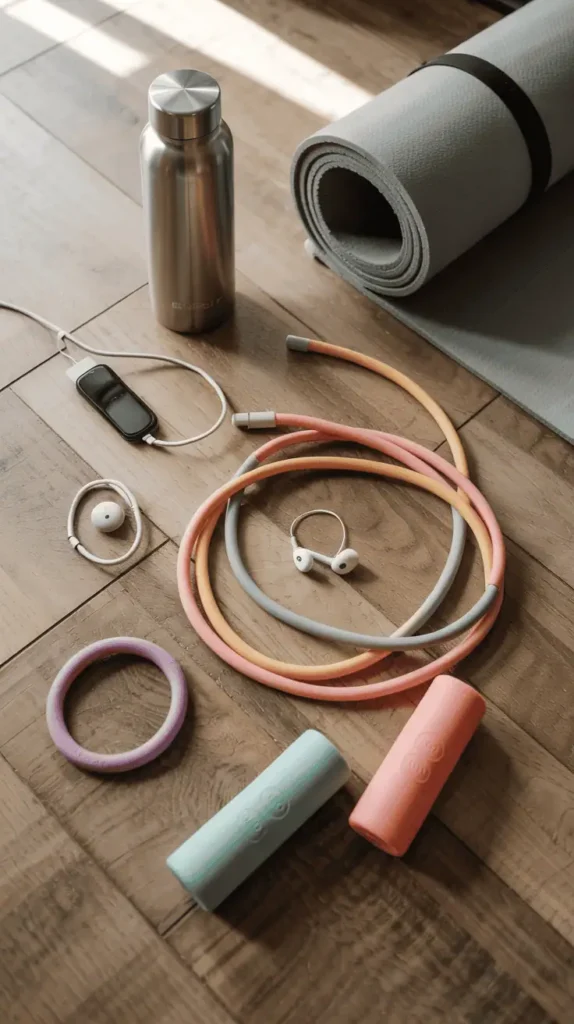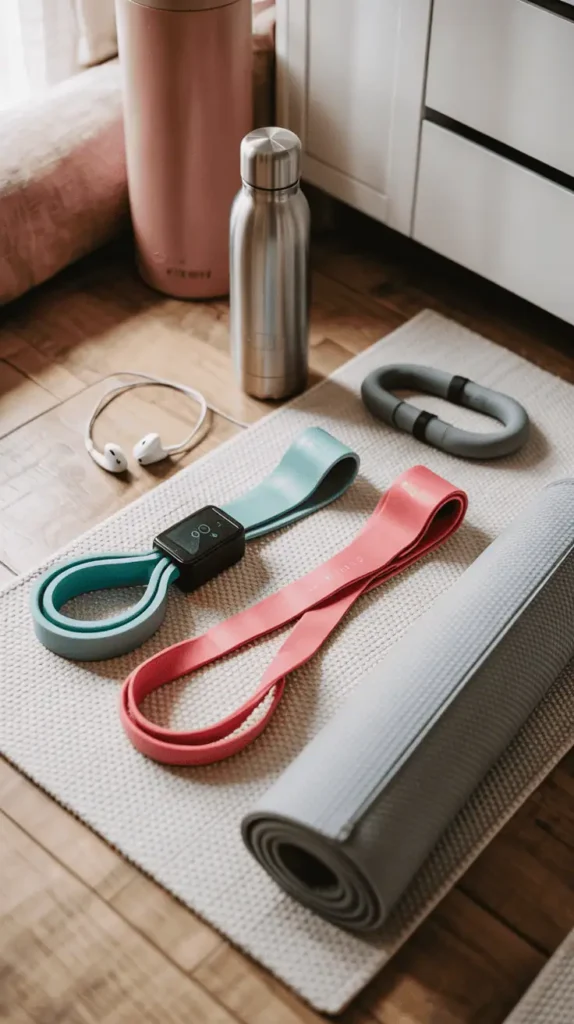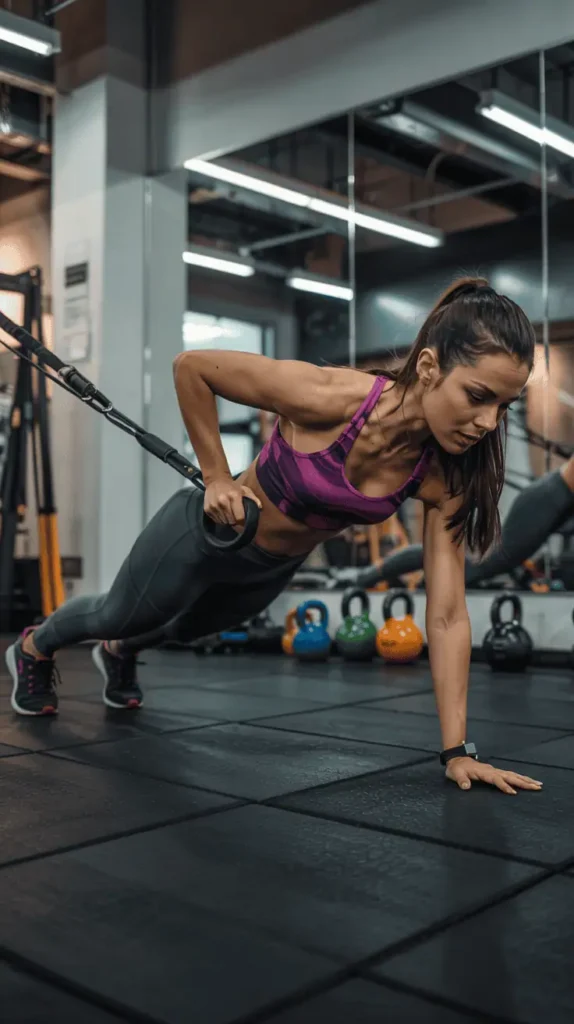(Hey! Some links in this post may be affiliate links — meaning I may earn a small commission if you buy through them, at no extra cost to you. As an Amazon Associate, I earn from qualifying purchases. I only share products I genuinely love and think you’ll find useful too. Read the full disclosure here).
Resistance band workouts are great for boosting strength and flexibility. They’re perfect for anyone, no matter their fitness level. You can work out different muscle groups and get a full-body workout with resistance bands.
They’re versatile and effective, making them a great addition to any fitness routine.
In this article, we’ll show you how to use resistance bands for a full-body workout. We’ll share tips and tricks to help you get the most out of your exercises. Whether you’re new to fitness or an experienced athlete, resistance band training can help you reach your goals.
Contents
- 1 What Are Resistance Bands?
- 2 How to Choose the Right Resistance Band
- 3 Getting Started with Your Resistance Band Workout
- 4 Full Body Resistance Band Exercises: Overview
- 5 Upper Body Resistance Band Exercises
- 6 Lower Body Resistance Band Exercises
- 7 Core Resistance Band Exercises
- 8 Creating a Full-Body Resistance Band Workout Routine
- 9 Tips for Maximizing Your Resistance Band Workouts
- 10 How to Progress Your Resistance Band Workout
- 11 Common Mistakes to Avoid
- 12 Frequently Asked Questions About Resistance Bands
What Are Resistance Bands?
Resistance bands are a favorite for those wanting to boost their fitness. They’re easy to use and work well at home or while traveling. They’re great for a full-body workout, hitting many muscle groups at once. This makes them a top pick for any resistance band routine.
There are many types of resistance bands to choose from. You can find loop bands, tube bands, and flat bands. Each type is designed for different exercises and muscle groups. For instance, loop bands are perfect for leg and glute workouts, while tube bands are better for the upper body.

Adding resistance bands to your routine can really improve your fitness. They help build strength, boost flexibility, and tone muscles. Plus, they’re light, easy to carry, and affordable. They’re ideal for anyone wanting to exercise at home or on the move. Whether you’re an experienced athlete or just starting, resistance bands can elevate your workout and show you the resistance band benefits firsthand.
How to Choose the Right Resistance Band
Starting a resistance band workout at home means picking the right gear. With many choices, it can feel overwhelming, even for newbies. To get the most from your resistance band strength training, think about the resistance level, band type, and brand.
A quality resistance band should challenge you just right. Look for bands with different resistance levels, like light, medium, and heavy. This lets you increase the workout as you get stronger. Also, pick a band type that fits your needs, like a loop or tube band.

Brands like Nike and Reebok are known for their top-notch resistance bands for resistance band strength training. When picking a brand, look at the material, how long it lasts, and the price. A great band is durable, easy to clean, and won’t break the bank.
- Think about the resistance level that matches your fitness level
- Choose a band made of tough material
- Check out brands like Nike and Reebok for quality bands
By keeping these points in mind, you can pick the perfect resistance band for your resistance band workout at home. Always go for quality and durability. And don’t be afraid to ask the maker if you have any questions or worries.
Getting Started with Your Resistance Band Workout
Starting a resistance band workout requires safety and the right setup. It’s a great way to boost fitness and strength. Choose a smooth, obstacle-free area for your workout. This ensures a safe and focused session.
Before you begin, warm up and get your muscles ready. Light cardio and dynamic stretches are good for this. A proper warm-up prevents injuries and boosts your workout performance.

Think about the exercises you’ll do when setting up. For active moves like squats or lunges, you need room to move. But for less active moves like curls or extensions, a smaller space works.
Safety Tips
- Always check your resistance bands for damage before using them.
- Begin with light resistance and increase it as you get stronger.
- Pay attention to your form and technique to avoid injuries.
Setting Up Your Space
Here are some tips for a good workout space:
- Find a quiet spot with no distractions.
- Make sure the surface is stable and non-slip.
- Keep a water bottle and towel nearby for comfort.
By following these tips, you can create a safe and effective workout area. Always focus on proper form and technique to maximize your workout and avoid injuries.
Full Body Resistance Band Exercises: Overview
Resistance band exercises are perfect for working out at home or while traveling. They target all major muscle groups. This type of training boosts your fitness and strength.
There are many full-body exercises to try. You can do upper body moves, lower body exercises, and strengthen your core.
For example, you can do upper body moves like bicep curls and tricep extensions. These exercises tone your arms.
Lower body moves, such as squats and lunges, work your legs and glutes. Core exercises, like planks and Russian twists, improve your balance and stability.

- Improved strength and tone
- Increased flexibility and mobility
- Enhanced core stability and balance
- Convenient and portable
Adding resistance band exercises to your routine offers many benefits. They help improve your fitness and well-being. Whether you’re new to working out or experienced, these exercises are a great challenge to reach your goals.
Upper Body Resistance Band Exercises
Working out your upper body is key in a full-body resistance band workout. Resistance band exercises are great for strengthening and toning this area. They offer a simple yet effective way to boost your fitness.
To start with upper body resistance band exercises, it’s important to know the different types. Some top exercises include:
- Bicep curls: This targets the biceps, helping to build strength and definition.
- Tricep extensions: This targets the triceps, helping to build strength and endurance.
- Lateral raises: This targets the shoulders, helping to build strength and stability.
These exercises can be adjusted to fit your fitness level. This makes them perfect for anyone starting a resistance band workout routine. Adding these exercises to your routine can help you target your upper body effectively and reach your fitness goals.

Lower Body Resistance Band Exercises
Working out your lower body is just as key as your upper body. A resistance band workout at home can be as good as going to the gym. It’s also super convenient. With resistance bands, you can work on your legs, glutes, and calves. This helps boost your resistance band strength training.
To start with lower body exercises, focus on a few key moves. These include:
- Squats: a great exercise for targeting the quadriceps, hamstrings, and glutes
- Glute bridges: an effective way to target the glutes and hamstrings
- Lunges: a compound exercise that targets the quadriceps, hamstrings, and glutes
These exercises can be adjusted for different fitness levels. You can do them with or without weights. For a resistance band workout at home, use the bands to add resistance. This makes the exercises more challenging and effective. By adding these exercises to your routine, you can get a stronger, more toned lower body.

Core Resistance Band Exercises
A resistance band workout that targets the whole body must focus on the core. A strong core boosts your stability, balance, and sports skills. We’ll look at some key core resistance band exercises for your routine.
First, it’s key to know why your core is important. It includes your abs, obliques, and lower back. Using resistance band exercises can strengthen your core and improve stability.
- Russian twists: This exercise targets your obliques and can be done by sitting on the floor with the resistance band anchored at shoulder height.
- Plank with band pull: This exercise targets your core and can be done by starting in a plank position and pulling the resistance band towards your chest.
- Standing oblique crunch: This exercise targets your obliques and can be done by standing with the resistance band anchored at shoulder height and crunching to one side.
Start slow and increase the resistance as you get stronger. Always focus on proper form and technique for the best results from your resistance band workout.
Creating a Full-Body Resistance Band Workout Routine
When setting up a resistance band routine, think about your fitness goals and current fitness level. A good routine can help you reach your goals, whether it’s to get stronger, more flexible, or healthier. Start by picking exercises that work different muscle groups, like the chest, back, shoulders, legs, and core.
A solid resistance band strength training plan should mix upper body, lower body, and core exercises. For the upper body, try bicep curls, tricep extensions, and chest presses. For the lower body, squats, lunges, and leg curls are great. Remember to add core exercises like planks and Russian twists to boost stability and balance.

- Start with lighter resistance levels and gradually increase the difficulty as you become stronger
- Include a mix of compound exercises, such as squats and deadlifts, and isolation exercises, such as bicep curls and tricep extensions
- Aim to work out 2-3 times per week, with at least one day of rest in between
By following these tips and mixing up your exercises in your resistance band routine, you can craft a balanced and effective workout. Always listen to your body and tweak your routine to avoid injury and prevent getting stuck in a rut.
Tips for Maximizing Your Resistance Band Workouts
To get the most out of your resistance band workout, focus on proper form and vary your routine. A well-structured workout can help you reach your fitness goals. Whether you want to build strength, increase flexibility, or improve health, resistance bands can help.
When doing resistance band exercises, engage your core and use slow, controlled movements. This keeps you safe and helps you avoid injury. Also, changing your routine by trying new exercises and increasing resistance keeps workouts fun and prevents boredom.
Here are some tips to help you maximize your resistance band workouts:
- Start with lighter resistance and gradually increase the tension as you become stronger
- Focus on slow, controlled movements to maintain proper form
- Vary your routine by changing the exercises and incorporating different types of exercises
- Engage your core and use proper breathing techniques to get the most out of your workout
By following these tips and adding resistance band exercises to your routine, you can create a great workout. Always remember to prioritize proper form and mix up your routine to keep things interesting and prevent boredom.
How to Progress Your Resistance Band Workout
As you keep up with your resistance band workout at home, it’s key to keep pushing yourself. You can do this by making your bands harder or by trying new exercises. This will help you get stronger and keep your workouts exciting.
Varying your routine is a big part of resistance band strength training. You can mix up your exercises to work different parts of your body. Start with simple moves like bicep curls and tricep extensions. Then, try more challenging ones like chest presses and rows.
- Increase the resistance level of your bands by using thicker or heavier bands
- Add new exercises to your routine, such as squats, lunges, and deadlifts
- Incorporate different types of exercises, such as cardio and strength training
- Focus on proper form and technique to get the most out of your workout
By following these tips, you can make your workouts more effective. Resistance bands are a great addition to any fitness routine, whether at home or in the gym.
Common Mistakes to Avoid
When doing a resistance band workout, it’s key to know common mistakes. These can cause injuries or make your workout less effective. Using the right form and not stretching the bands too much is very important.
A resistance band workout can boost your fitness. But, you need to pay attention to how you do it. Start with a good warm-up and slowly add more resistance as you get better.
Overstretching Bands
Stretching the bands too much can hurt you and make your workout less good. Start with a lighter resistance. Then, slowly add more as you get used to the exercises.
Improper Form
Bad form can also hurt you and make your workout less effective. To avoid this, move slowly and control your movements. Also, keep your core tight and your posture right.
Knowing these common mistakes helps you have a safe and effective workout. Always focus on proper form and technique. If you’re unsure, adjust the resistance or ask for help.
Frequently Asked Questions About Resistance Bands
Starting your resistance band workout? You might have some questions. Let’s cover some common ones to help you get the most out of your training.
How Often Should I Work Out?
How often you work out with resistance bands depends on your fitness level and goals. Most people do 2-3 full-body sessions a week. This allows for rest and recovery. Listen to your body and adjust as needed.
Can I Use Resistance Bands Instead of Weights?
Yes, you can! Resistance bands are a great alternative to weights. They offer a challenging and versatile workout. While not as heavy as weights, bands can effectively tone your muscles. Add them to your routine to complement or replace weight training.







